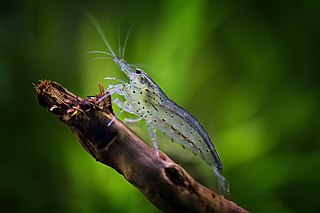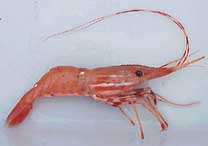
Caridina multidentata is a species of shrimp in the family Atyidae. It is native to Japan and Taiwan. Its common names include Yamato shrimp, Japanese shrimp, Amano shrimp, and algae shrimp.

Parkia speciosa, the bitter bean, twisted cluster bean, sator bean, or stink bean, is a plant of the genus Parkia in the family Fabaceae. It bears long, flat edible beans with bright green seeds the size and shape of plump almonds which have a rather peculiar smell, similar to, but stronger than that of the shiitake mushroom, due to sulfur-containing compounds also found in shiitake, truffles and cabbage.

The giant basket star, Astrophyton muricatum, is an echinoderm found in shallow parts of the tropical western Atlantic and throughout the Caribbean Sea and the Gulf of Mexico. It is the only species in the genus Astrophyton. During the day, it curls up into a tight ball shape to protect itself from predators. At night, it climbs to an elevated point to feed by extending its intricately branched feeding arms in a bowl-like shape in order to snare passing plankton and other organisms from the current.

Alcyonacea are a species of sessile colonial cnidarians that are found throughout the oceans of the world, especially in the deep sea, polar waters, tropics and subtropics. Whilst not in a strict taxonomic sense, Alcyonacea are commonly known as "soft corals" (Octocorallia) that are quite different from "true" corals (Scleractinia). The term “soft coral” generally applies to organisms in the two orders Pennatulacea and Alcyonacea with their polyps embedded within a fleshy mass of coenenchymal tissue. Consequently, the term “gorgonian coral” is commonly handed to multiple species in the order Alcyonacea that produce a mineralized skeletal axis composed of calcite and the proteinaceous material gorgonin only and corresponds to only one of several families within the formally accepted taxon Gorgoniidae (Scleractinia). These can be found in order Malacalcyonacea (taxonomic synonyms of include : Alcyoniina, Holaxonia, Protoalcyonaria, Scleraxonia, and Stolonifera. They are sessile colonial cnidarians that are found throughout the oceans of the world, especially in the deep sea, polar waters, tropics and subtropics. Common names for subsets of this order are sea fans and sea whips; others are similar to the sea pens of related order Pennatulacea. Individual tiny polyps form colonies that are normally erect, flattened, branching, and reminiscent of a fan. Others may be whiplike, bushy, or even encrusting. A colony can be several feet high and across, but only a few inches thick. They may be brightly coloured, often purple, red, or yellow. Photosynthetic gorgonians can be successfully kept in captive aquaria.

Acetes is a genus of small shrimp that resemble krill, which is native to the western and central Indo-Pacific, the Atlantic coast of the Americas, Pacific coast of South America and inland waters of South America. Although most are from marine or estuarine habitats, the South American A. paraguayensis is a fresh water species. Several of its species are important for the production of shrimp paste in Southeast Asia, including A. japonicus, which is the world's most heavily fished species of wild shrimp or prawn in terms of total tonnage.

Syncaris pacifica is an endangered species of freshwater shrimp in the family Atyidae that occurs only in a limited range within the northern San Francisco Bay Area, California, USA. Specifically, this species occurs only in 17 stream segments within Sonoma, Napa and Marin Counties. This species is often translucent to transparent, with both sexes capable of considerable coloration altering, as a sophisticated form of camouflage. This decapod is commonly known as California freshwater shrimp, and is the only extant decapod shrimp in California that occurs in non-saline waters.

The vernal pool fairy shrimp, Branchinecta lynchi, is a species of freshwater crustacean in the family Branchinectidae. It is endemic to the U.S. states of Oregon and California, living in vernal pools as well as non-vernal pool habitat. They range in size from 0.43 to 0.98 inches long. Vernal pool fairy shrimp are listed as a vulnerable species on the IUCN Red List, and has been listed as Federally Threatened species since 1994.

Pandalus platyceros, also called California spot prawn or Alaskan prawn, is a shrimp of the genus Pandalus.

Lysmata is a genus of shrimp in the infraorder Caridea, the caridean shrimp. The genus belongs to the family Lysmatidae. Lysmata are popular ornamental shrimp in the marine aquarium trade for their bright color patterns, interesting behaviors, and ability to control certain aquarium pests such as sea anemones of the genus Aiptasia. They are known to command high prices on the pet market.

Phenacovolva rosea, also known as the rosy spindle cowry, is a species of sea snail, a marine gastropod mollusc in the family Ovulidae, the ovulids, cowry allies or false cowries. It lives and feeds on fan, whip and bush-type gorgonians.

Amonovula piriei is a species of sea snail, a marine gastropod mollusk in the family Ovulidae, the ovulids, cowry allies or false cowries.

Leptogorgia virgulata, commonly known as the sea whip or colorful sea whip, is a species of soft coral in the family Gorgoniidae.

Millepora alcicornis, or sea ginger, is a species of colonial fire coral with a calcareous skeleton. It is found on shallow water coral reefs in the tropical west Atlantic Ocean. It shows a variety of different morphologies depending on its location. It feeds on plankton and derives part of its energy requirements from microalgae found within its tissues. It is an important member of the reef building community and subject to the same threats as other corals. It can cause painful stings to unwary divers.

Neocaridina zhangjiajiensis, known as the pearl shrimp in the aquarium hobby, is a freshwater shrimp. Multiple breeds were bred in Germany for the aquarium trade.

Cantherhines macrocerus, commonly known as the whitespotted filefish or American whitespotted filefish, is a marine fish found along the coast of Florida extending southward into the Caribbean. This species is distinct and separate from Cantherhines dumerilii, the similarly named whitespotted filefish which is found in the Indian and Pacific oceans.

Manipontonia is a genus of shrimp comprising the following species:

Eunicella singularis, the white gorgonian, is a species of colonial soft coral, a sea fan in the family Gorgoniidae. It is found in the western Mediterranean Sea, Adriatic Sea and Ionian Sea. It was first described in 1791 by the German naturalist Eugenius Johann Christoph Esper.

Conopea galeata is a species of colonial barnacle in the family Archaeobalanidae. It lives exclusively on gorgonians in the western Atlantic Ocean, the Caribbean Sea and the Gulf of Mexico.

Stenopus pyrsonotus is a shrimp-like decapod crustacean belonging to the infraorder Stenopodidea, native to the Indo-West Pacific region. Common names include flameback coral shrimp, ghost boxing shrimp and cave shrimp; the species is sometimes kept in reef aquariums.
Mesopontonia gorgoniophila is a species of shrimp in the family Palaemonidae that was first described in 1967 by Alexander James Bruce. The specific name, gorgoniophila, describes the species as being a lover of gorgonians, given because it is found amongst gorgonian corals.


















